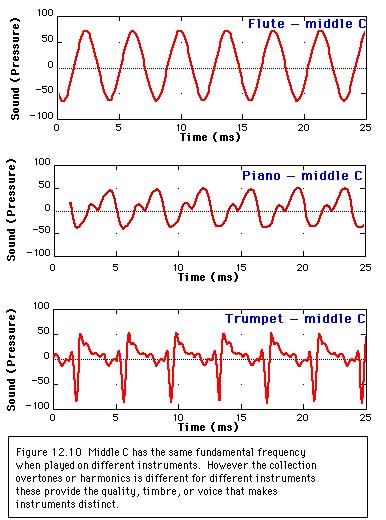|
|

|
|


Figure 12.10 shows the sound wave for the note middle C played
on a flute, a piano, and a trumpet; this is what you would see
on an oscilloscope connected to a microphone when each of these
instruments plays the note middle C. The fundamental frequency
is the same for each-262ÊHz. The overall, general shape
of the sound wave is the same for each instrument in that each
sound wave repeats itself 262 times a second. The sound wave from
the flute is very smooth and looks like a sine wave from a mathematics
textbook. A flute has a strong fundamental frequency of 262 Hz
and practically no other harmonics or overtones. A musician might
describe a flute as having a very pure tone. The sound waves for
the piano and trumpet bear the same the overall, general shape
in that they, too, repeat themselves 262 times a second; each
still has a fundamental frequency of 262 Hz. But these have more
wiggles and are generally more complex. In addition to the fundamental
frequency of 262 Hz, they each have additional-and different-harmonics
present. Figure 12.11 shows the additional harmonics that are
present; this is known as an acoustic spectrum. It is the number
and relative strength of these various harmonics that give each
instrument its distinctive sound-its quality or timbre or voice.
An electronic synthesizer creates (or recreates) different voices
by combining a fundamental frequency with various harmonics. By
doing this a synthesizer can create a sound that matches an existing
instrument or create an entirely new sound.

While loudness, pitch, and quality-or amplitude, frequency, and
harmonics-may be the most important characteristics or distinctives
of a musical sound, two more characteristics are attack and decay.
Attack refers to how a sound begins while decay refers to how
a sound ends. Does the sound begin very abruptly and then continue
at a constant level? Or does it begin softly and gradually increase
in amplitude and loudness? Does the sound continue and then suddenly
stop or does it die away gradually. Different instruments behave
differently. A synthesizer or keyboard will use various attacks
and decays to provide different sounds or voices. We may describe
these as the envelope of the sound wave-the overall pattern of
the sound wave. Figure 12.12 illustrates different musical sounds
played on a keyboard that allows different attack and decay envelopes.


|
|